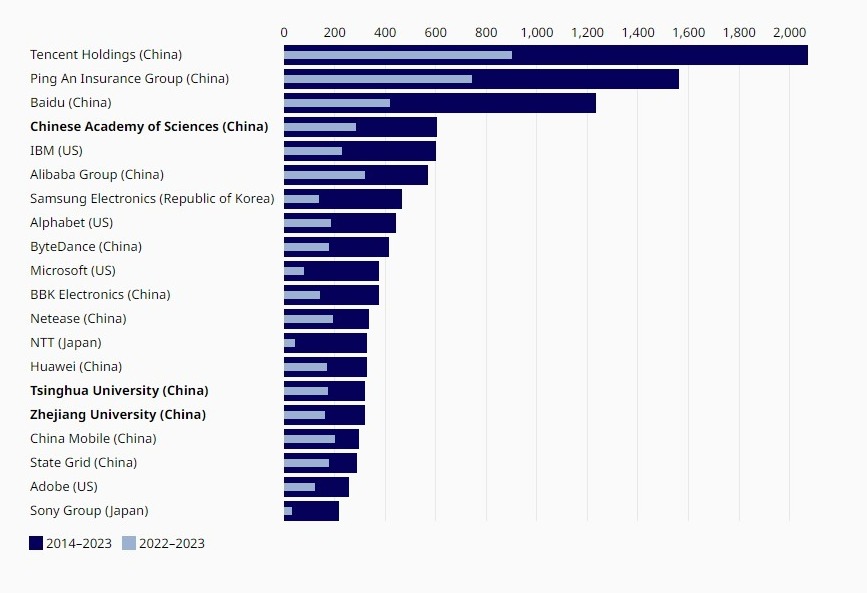China is currently at the forefront of the global race in generative artificial intelligence (GenAI) patents, significantly outpacing other nations. According to a recent report by the World Intellectual Property Organization (WIPO), China has filed more than 38,000 GenAI patents between 2014 and 2023. This figure dwarfs the 6,276 patents filed by U.S.-based inventors during the same period.
Generative AI, a type of artificial intelligence that enables the creation of content such as text, images, music, audio, and videos, has seen a sharp rise in patenting activity. This rapid growth coincides with significant technological breakthroughs, such as the introduction of transformer models in 2017 and the launch of ChatGPT in 2022.
China’s dominance in numbers
The WIPO report highlights that China is not just leading but dominating the field of generative AI patents. The country has filed six times more patents than the United States, with significant contributions from top Chinese tech giants. Tencent leads with 2,074 patents, followed by Ping An Insurance with 1,564 and Baidu with 1,234. Other notable contributors include the Chinese Academy of Sciences and Alibaba Group.

U.S. companies like IBM, Alphabet, and Microsoft are also active in this space but trail far behind. IBM has filed 601 patents, Alphabet 443, and Microsoft 377.
The report reveals that China’s lead extends beyond the United States. South Korea, Japan, and India have filed 4,155, 3,409, and 1,350 patents, respectively. European countries are even further behind, with the United Kingdom and Germany filing 714 and 708 patents, respectively.
Image and video data dominate the GenAI patents, with 17,996 inventions in this category. Text (13,494 patents) and speech or music (13,480 patents) follow.
WIPO anticipates even more growth in the coming months, predicting a “wave of patent applications” sparked by the launch of ChatGPT in late 2022. Due to the typical 18-month lag between filing and publication, this surge is expected to become visible in patent data from 2024 onwards.
OpenAI’s strategy under scrutiny
Founded as a non-profit organization, OpenAI initially encouraged its researchers to publish and share their work openly. This ethos aimed to benefit humanity by promoting transparency and collaboration in AI development. OpenAI’s mission was to “ensure that artificial general intelligence benefits all of humanity,” which was reflected in its open-source initiatives.
However, in 2019, OpenAI restructured into a “capped” for-profit entity, splitting into the non-profit OpenAI Inc. and the for-profit subsidiary OpenAI Global LLC. This move attracted substantial investment from Microsoft, among others, indicating a shift towards a more commercially driven approach. As a result, OpenAI’s stance on intellectual property began to change.
WIPO’s report highlights that OpenAI only started filing patents in early 2023. “Six US patents from OpenAI were published in the first quarter of 2024, indicating a change of IP strategy and the creation of a patent portfolio,” states the report. This late entry into the patent game raises questions about how OpenAI plans to protect its technological advancements and maintain its competitive edge.
The future ahead
China’s strategic emphasis on AI research is evident. In May, the Chinese government launched a three-year “action plan” to bolster standards in AI chips, generative AI, and national computing power. This initiative aims to drive technological and economic development, reinforcing China’s leading position in the global tech race.
While quantity doesn’t always equate to quality in research, China’s sheer volume of patents and publications suggests a deep commitment to advancing generative AI technology.
The surge in generative AI research is mirrored in scientific publications as well. The number of related scholarly articles has skyrocketed from around 100 in 2014 to over 34,000 in 2023.
The full WIPO report is well worth reading. It offers a comprehensive and up-to-date view of the generative AI landscape. Beyond the patent data, the report explores various GenAI models and modes, highlights key industrial application areas, and addresses broader considerations such as ethical concerns, potential misuse, and job displacement risks.
